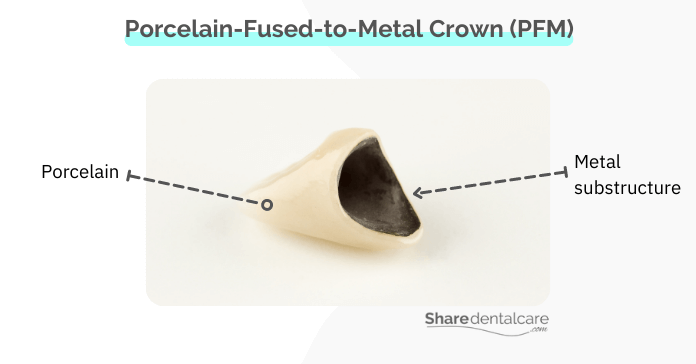When it comes to dental crowns, porcelain is a popular choice. Porcelain is used in dentistry because it is a biocompatible, strong, and aesthetic material. Porcelain-fused-to-metal crowns are strong and durable but still susceptible to chips and cracks. Luckily, there are porcelain repair methods that can fix a chipped crown, but with some limitations. In this blog post, we’ll discuss how to repair a chipped crown with exposed metal and the common causes of a chipped crown.
Causes of Chipped or Broken Dental Crowns
Porcelain-fused-to-metal crowns (PFM) are the most common type of crowns used because they mimic the natural teeth’ color and shape and are less expensive than All-ceramics crowns. PFM consists of a metal substructure covered by a layer of porcelain, which makes it a strong and aesthetic crown. However, chipping or cracking can happen for several reasons:
- Trauma: chipping may result from injury to the mouth, like when playing contact sports.
- Poor oral habits: chewing a pin or biting down on hard objects such as ice cubes can chip or crack the crown from the pressure exerted.
- Bruxism: grinding and clenching your teeth at night can crack a crown from the force exerted by the muscles in your face, neck, and jaw.
- Malocclusion: improper alignment of the teeth can lead to pressure being exerted on the crown, which may cause it to chip or break.
Excessive force on a porcelain-fused-to-metal crown can cause chipping or cracking of the porcelain, exposing the metal substructure. To repair the chipped crown with exposed metal, schedule an appointment with your dentist. If the chipped crown is causing you sensitivity or pain, then see a dentist immediately.

How to Repair a Chipped Porcelain Crown with Exposed Metal?
If you chipped your crown, schedule an appointment with your dentist. The dentist will look at the chipped crown and exposed metal and determine whether they can repair it or the damage is too extensive.
- Small chipping: your dentist may be able to repair the chipped crown with exposed metal using a specific porcelain repair kit. This kit contains a composite material that can be bonded to the PFM crown. Composite resin is the same material used in tooth bonding.
- Large fracture: If damage is too extensive and the crown cannot be repaired, then you may need to get a new crown.
The drawback of the crown repair procedure is that it only works on small fractures. If the chipped crown with exposed metal is too large, then the dentist may decide to replace the crown instead of repairing it.
Repair or Replace Chipped Crown with Exposed Metal?
If you have a chipped crown with exposed metal, your dentist will decide between two options, repair or replace. Before choosing one of these options, you should consider the following factors:
- The size of the fracture: If it is small, the crown may be repaired. However, if it is too large, you will need a new crown.
- The chipped area: chipping can affect the biting surface of the crown or around the margins, which can affect the crown’s appearance and strength. If chipping does not compromise strength and appearance, then it can be repaired.
- Causes of fracture: If chipping occurred from grinding and clenching your teeth at night, then you should consider getting a new solid zirconia crown instead of a PFM crown because solid zirconia is less likely to chip or fracture.
- The presence of pain or tooth decay: If the crown tooth causes pain or has tooth decay, then your dentist will remove the chipped crown and treat the tooth. In this case, you will need a new crown.
- Age of crown: If the chipped crown is very old, then you may need to replace it.
- Durability: a new crown will last longer than a repaired one.
- The cost: getting a new crown will cost you more than repairing the chipped one.
- The dentist’s ability: you should be sure to choose a dentist with experience in repairing crowns. Also, repairing a crown require a very specific porcelain repair kit, which may not be available at all dental offices.
To decide whether to repair a chipped crown with exposed metal or get a new one, schedule an appointment with your dentist. They will evaluate the chipped crown to determine whether it can be repaired or should be replaced, and what is the cost of both. Learn more about what to do if your temporary crown is chipped.
How to Properly Take Care of a Dental Crown and Make It Last?
The most important thing you can do to prolong the life of your dental crown is to take care of it properly. Here are some tips:
- Brush your teeth twice a day for two minutes with a soft-bristled brush and fluoride toothpaste.
- Floss daily to avoid plaque and bacteria buildup.
- Avoid chewing hard foods such as candies.
- Use a nightguard if you have teeth-grinding or clenching.
- Stop poor oral habits such as chewing pens, ice, or hard objects.
- Schedule regular dental checkups and cleanings to keep your mouth healthy.
Repair a Dental Crown with Exposed Metal – Conclusion
Porcelain-fused-to-metal crowns (PFM) are strong and durable. However, they are prone to chipping and fracture. If your crown is chipped and the metal substructure is exposed, you have two options: either repair or replace it. Repair is recommended if the chipped area is small and doesn’t compromise the strength and appearance of the crown. Otherwise, consider replacing it with a new one. Talk to your dentist to know which option is suitable for you.